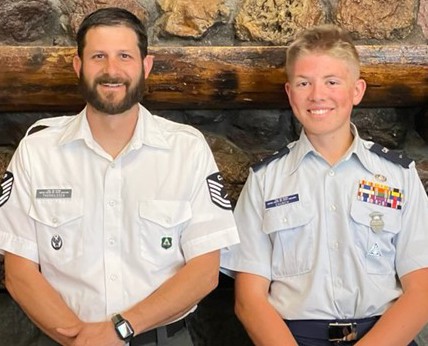Safety First: Idaho Team Copes with Encampment Summer Heat

 Tech. Sgt. Damen Therkildsen, Idaho Wing assistant safety director, met the challenge of soaring summer temperatures head-on recently by crafting an innovative approach as safety director for the wing’s recent Mountain Eagle Encampment.
Tech. Sgt. Damen Therkildsen, Idaho Wing assistant safety director, met the challenge of soaring summer temperatures head-on recently by crafting an innovative approach as safety director for the wing’s recent Mountain Eagle Encampment.
Before the encampment began, Therkildsen asked cadet staff to provide him with a cadet safety officer to provide assistance throughout the week. That assignment went to Cadet 2nd Lt. Nathan Church of the Eagle Rock Composite Squadron.
“I saw this as an opportunity to train a cadet in safety, but more importantly to have an assistant embedded within the same age range as the cadets that were attending encampment,” Therkildsen said. In addition, another wing assistant safety director, Maj. Paul Young, helped train Church when Therkildsen was otherwise engaged.
Church’s involvement “gave cadets a chance to confide in someone within their age range and within their own chain of command,” Therkildsen said.
“Cadet Church became a leading indicator for me as the safety officer on things to watch out for during my daily risk assessments,” he said. “I also ensured that he helped me with the daily risk assessment and helped me think of things I may not have considered as an adult, but to use his youth and experience as a cadet to think outside of the box.”
Therkildsen drew on his background as a safety and health professional with a degree in occupational safety and health, including experience working with the Department of Defense, Department of Veterans Affairs, and the Forestry Service.
“I am used to working in high-risk environments, and I approached encampment as a high-risk environment as well,” he said.

“My style of safety is based around learning, enabling, and providing a conduit for learning,” Therkildsen said. When he first met with encampment staff and the basic cadets, “I made sure to tell them that this would be a learning experience throughout the week. This was a shift for them, as they have been accustomed to safety officers that are more like the safety police and are used to hearing ‘no’ all the time.
“I worked with them to help them be a part of the process to make sound decisions throughout the week,” he said.
Mindful of the possibility of serious heat injuries with temperatures forecast in the high 90s and low 100s, “I had each tactical training officer install the OSHA Heat Index app on their phone,” Therkildsen said. “This was a tool that we all used hourly to keep track of our day.
“When the heat entered the upper warning area of the indicators on the app, we would find ways to continue the various activities we were doing throughout the week,” he said. “Sometimes it meant taking more frequent breaks in shady areas, consuming more water, and for several days we had cadets wear (physical training) gear instead of their ABUs to stay cooler.
“One item that the cadet flight staff did was come up with chants that reminded them to drink water frequently.“

As temperatures climbed to danger levels, the cadets had to be trained not to move as rapidly as usual in assembling for formation, and cadet staff focused on gathering them in shady areas, Therkildsen said.
An after-action review each evening focused on what went well during the day and what needed improvement.
“The first couple of days I could feel a tension in the air as cadets learned to not blame and shame and instead convert to a culture of learning,” Therkildsen said. “Once they realized that they could air their concerns without blaming anyone in a tactful leaning manner, more people were willing to share their experience and help us all improve and create a safe environment throughout the rest of the week.
“One of our biggest successes was how well safety, medical, and logistics worked together each day. We communicated what was going on and the anticipated needs based on what events were occurring,” he said. “Logistics would have water waiting at events prior to cadets arriving. Medical staff would preposition their staff at various sites in case a cadet started to experience symptoms of a heat injury.
“We were proactive in our approach to stay on top of anticipated events and catching things early and ensuring the needed resources were where they needed to be.”

